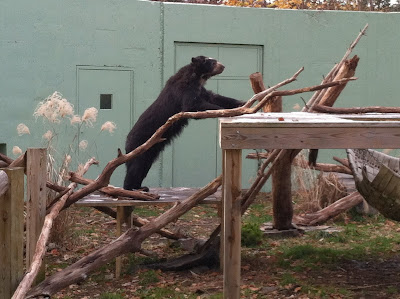 |
| Bernard checking out his new exhibit |
Andean bears, also called spectacled bears, typically live in high-alititude cloud forests in the Andes Mountains in South America. They are the only South American bear and are actually one of the smallest species of bear. These bears are typically very shy and are hardly ever seen in the wild. Andean bears get the nickname "spectacled bears" because of the tan and black markings around their eyes that resemble glasses. These markings are like a human's fingerprints: each bear's markings are unique.
 |
| Bernard continuing to explore |
Because these bears are so reclusive, it is hard to gauge how many are left in the wild. Most biologists estimate that there are fewer than 3,000 left in the wild, which classifies them as "vulnerable to extinction." These bears only have 1-2 cubs each year, and only during years when fruit is plentiful, so they do not repopulate quickly. Andean bears are in such a precarious position due to habitat destruction and poaching. Logging companies and expanding towns destroy their forest habitats, and poachers kill them to sell their body parts. Farmers even kill them as agricultural pests because these bears eat crops and livestock.
As a result, Andean bears are part of a monitored breeding program in zoos across the country to preserve genetic diversity and hopefully breed bears to release into the wild. These bears are very difficult to breed in captivity and are called "soul-mate bears" because they will only breed with the "perfect" bear. In fact, only one spectacled bear in the U.S. has given birth to cubs in the last six years. Billie Jean, at the National Zoo, gave birth to two cubs in 2010 and two more cubs this year. Before that, Billie Jean herself is the last surviving Andean bear born in the U.S. Even though the Binghamton Zoo is not planning to breed Chica and Bernard, housing both of these bears gives others zoos room to breed younger bears.
We can't just throw Chica and Bernard together and hope for the best. I am one of two keepers working on introducing the bears. Right now, they have separate indoor dens and get separate time outside in the exhibit. If Chica is out in the exhibit, we will let Bernard into her den to sniff around and play with her toys. This way, the bears get used to each others' scents. Eventually, we will let the bears see each other through a "howdy door." This big mesh door is pinned in place between dens and will let the bears see, smell, hear, and touch each other, but will not let them actually be together. If all goes well, we will then put the bears together. Generally, elderly Andean bears are not put together in zoos, so we are doing this as part of a behavioral study that may set a precedent for other zoos.
Stay tuned to see how Bernard and Chica get along!
No comments:
Post a Comment